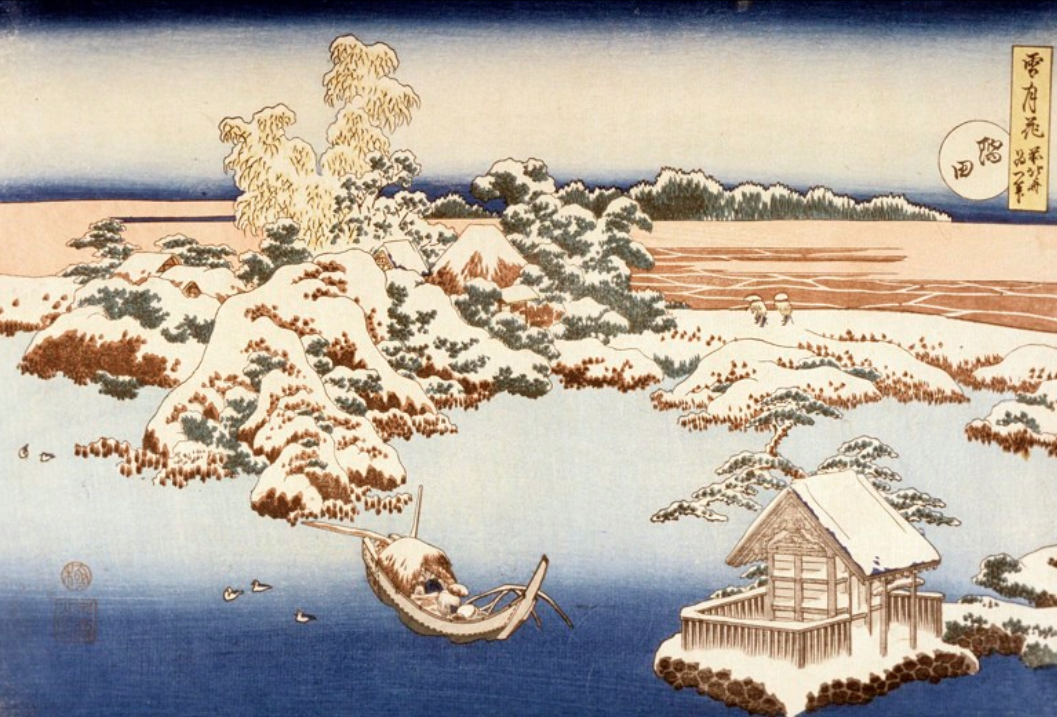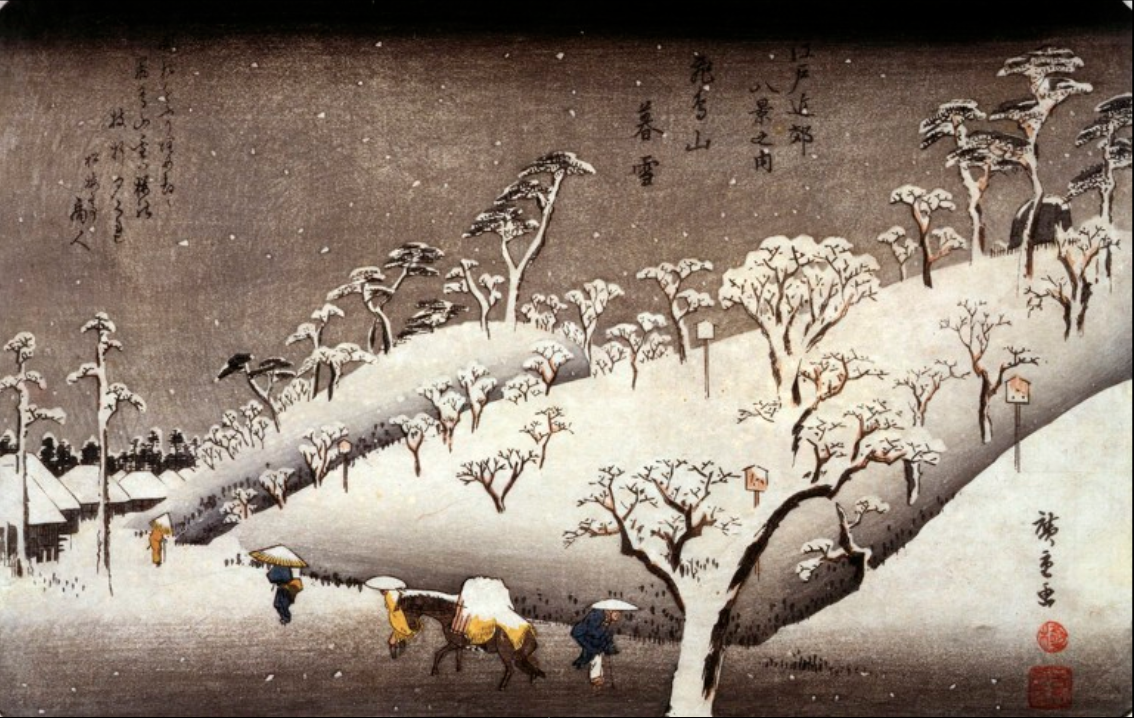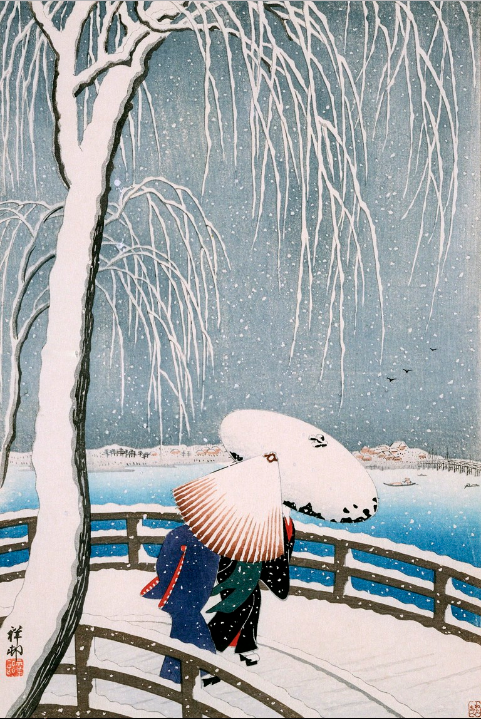Let It Snow
We have had several snowfalls in the past couple of weeks. On Presidents’ Day I found myself staring at a snow-laden tree across the street and thinking, that looks like a Japanese woodcut of a snow-laden tree. The whole process of multiple woodblock prints of the ukiyo-e period (ca. 1660s–1860s) was so complicated, I imagine snow scenes were just another one of those complications. Below are three examples of the beautiful woodcut technique used by ukiyo-e block-cutters to create snow scenes from brush drawings by the artists.
Let’s first establish the hierarchy of tasks in the ukiyo-e woodcut print process:
- The artist draws the composition for the print, and gives instructions to the printer for what colors go where.
- The woodblock carver(s) cut different blocks each for one color as indicated by the artist.
- Each block is printed, starting with the block bearing the contour lines of the composition.
- The publisher inspects quality.
- Tokugawa censors inspect the prints to approve that they did not contain any political or anti-social content and put their seal on the print
The tedious process of producing prints from the artists’ drawings began with an outline drawing (sen-gaki) of all of the contour lines that established the major forms of the composition. This was traced from the artist’s original drawing using minogami paper that was thin enough to trace with. The resulting traced image was transferred to the woodblock and became the foundation block for the finished print called hanshita-e.
As each block was carved for from nine to twelve colors, they were aligned during printing along an L-shaped mark in the lower right corner of each separate sheet.
 |
| Katsushika Hokusai (1760–1849), Snow on the Sumida River, from the series Snow, Moon and Flower, ca. 1832. Color woodcut print on paper, 9 13/16" x 14 15/16" (25 x 38 cm ). © 2019 Philadelphia Museum of Art. (PMA-1406) |
Hokusai is undoubtedly responsible for the popularity that evolved for series of landscape prints. This was based on his series Thirty-Six Views of Mount Fuji, produced between 1826 and 1830. Hokusai explored the possibility of atmospheric snow scenes more than any previous ukiyo-e artists. His drawings would indicate which colors went where. I’m wondering if the woodblock carvers were relieved to do snow scenes that used the paper as the negative space?
In Snow on the Sumida River, the introduction of Western chemical inks (aniline) gave the printers who inked the carved blocks extra steps to do. The artist would indicate where he wanted the colors in his original drawing, including areas that should be rubbed to give the effect of gradated color, seen in this print in the foreground water and background sky.
 |
| Utagawa Hiroshige I (1797–1858), Evening Snow on Asuka Mountain, block #1 from the series Eight Views in the Environs of Edo, ca. 1838. Color woodcut print on paper, 9" x 14 9/16" (23 x 37 cm). © 2019 Brooklyn Museum. (BMA-840) |
Of all the ukiyo-e artists who specialized in landscape prints, Hiroshige was undoubtedly responsible for refining the atmospheric snow scenes with which we are now so familiar. His directions to the block carvers established the practice of depicting falling snow by putting tiny gouges into the blocks printing the dark colors of the composition. This is clearly seen in Evening Snow on Asuka Mountain in the sky and also in the shading in the bottom of the print.
Hiroshige produced more than 1500 snow scenes during his career. When Hokusai’s Thirty-Six Views of Mount Fuji was published, Hiroshige was still producing prints of bijin-ga (beautiful women) and Kabuki actors. Inspired by the range of possibilities in landscape composition, he produced his first series Famous Places in the Eastern Capital in the early 1830s.
 |
| Ohara Koson (1877–1945), Willow Bridge in Winter, 1918. Color woodcut print on paper, 14 5/16" x 9 ½" (36.3 x 24.2 cm). © 2019 Worcester Art Museum. (WAM-333) |
The ukiyo-e style of prints of everyday life, beautiful women, actors, and landscapes waned in popularity as Japan rapidly westernized at the end of the 1800s. In the early 1900s, artists who reacted against the rapid industrialization of the country attempted a revival of the style in the shin hanga (new print) and sosaku hanga (artistic print) movements. Shin hanga copied the old hierarchy of artist-block carver-publisher, while sosaku hanga artists drew the composition, carved the blocks, and made the prints themselves.
Ohara Koson is considered by many scholars to have been one of the foremost of the shin hanga artists. He certainly emulated beautifully the snow scenes of Hiroshige. As you can see in Willow Bridge, he made sure that the artists indicated the falling snow by putting little gouges in the woodblocks carved for the colors of the sky, the water, the railings, and even the garments on the two pedestrians.

Comments